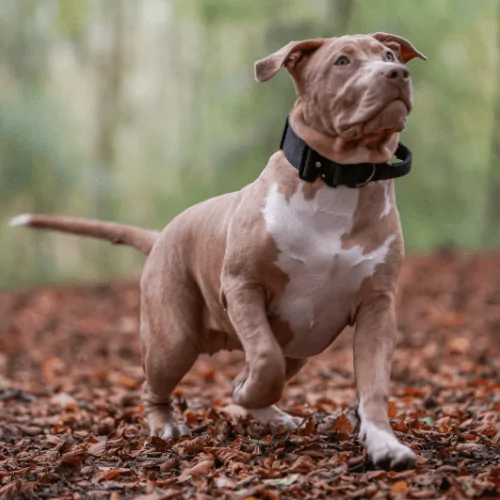
XL Bully ban UK: What does it mean for my dog?

Dr Scott Miller
4 October 2023
Recent news coverage of a man who was fatally attacked by two suspected American XL Bullies will understandably have pet parents worried.
Below, expert vet Dr Scott Miller is here to support you by talking through the proposed government breed ban.
Find out what the ban means for you if you have an XL Bully and what steps you can take to keep them in the family.
- Why is the XL Bully being banned in the UK?
> When will the XL Bully become a banned breed?
> How can I tell if I own an XL Bully? - What does the upcoming UK ban mean for my existing American XL bully?
> Who can I speak to about my XL Bully’s behaviour? - What is the Dangerous Dogs Act and why was it introduced?
> Why can’t you insure dogs listed under the Dangerous Dogs Act?
> Does Breed Specific Legislation (BSL) work?
> Can UK law around banned breeds be changed?

Why is the XL Bully being banned in the UK?
The American XL Bully is a variation of the American bully but isn’t recognised by the Kennel Club as an official breed in the UK.
The UK government has called for a ban on XL Bullies due to a number of attacks – some fatal – by the breed over recent years.
The proposal means that the XL Bully would be the fifth addition to the list of banned breeds in the Dangerous Dogs Act 1991.
> When will the XL Bully become a banned breed?
From 31 December 2023, the following will be illegal for XL Bullies:
• Breeding
• Selling
• Advertising
• Rehoming
• Abandoning
• Allowing an XL Bully dog to stray
From 1 February 2024 , it will then become illegal to own an XL Bully dog if you haven’t registered them on the Index of Exempted Dogs.
And up until 30th June 2024, any XL Bully over one year old will need to be neutered.
> How can I tell if I own an XL Bully?
The government has confirmed that the general impression of an XL Bully is a large dog with a muscular body and blocky head, suggesting great strength and power for its size.
The have released an official XL Bully definition that outlines features including the body, head, teeth, neck, and forequarters. Have a careful read of this definition to see if it matches up with the features of your Bully dog.

What does the upcoming UK ban mean for my existing American XL bully?
It’s understandable to feel worried, but try not to panic. The good news is that the government has confirmed that there will be an amnesty period for XL Bully parents to register their dogs.
You may be able to keep your dog if the court thinks they’re not a danger to the public. Your dog must be:
- Neutered
- Microchipped
- Kept on a lead and muzzled at all times when in public
- Kept in a secure place so they can’t escape
You’ll be given a Certificate of Exemption which is valid for the life of your dog. This also means you’ll need to:
- Be over 16 years old
- Insure your dog against injuring other people
- Show your Certificate of Exemption when asked by a police officer or council dog warden, either at the time or within 5 days
- Update the Index of Exempt Dogs if you change address or your dog dies – you can call on 020 8026 4296 or email [email protected]
> Who can I speak to about my XL Bully’s behaviour?
As we’ve mentioned, you’ll need to prove your dog isn’t (or won’t be) a danger to the public to get an exemption.
Speak to a professional dog behaviourist if you need support or advice about your XL Bully’s behaviour.
They can also help with things like training your Bully to use a muzzle.

What is the Dangerous Dogs Act and why was it introduced?
The Dangerous Dogs Act was introduced in 1991 to help protect public safety and encourage responsible ownership following a run of dangerous dog attacks.
The Act allows the government to ban dogs who look like or have the characteristics of a dog bred for fighting.
The law makes it illegal to own the following dogs or any dog breeds mixed or crossed with this list:
- Pit Bull Terrier
- Japanese Tosa
- Dogo Argentino
- Fila Brasileiro
You’re also not legally allowed to:
- Sell a banned dog
- Abandon a banned dog
- Give away a banned dog
- Breed from a banned dog
> Why can’t you insure dogs listed under the Dangerous Dogs Act?
Sadly most insurers, including Petsure, aren’t able to cover dogs listed under the Dangerous Dogs Act.
But there are options out there for getting dog third-party liability cover for your XL Bully:
- Becoming a member of Dogs Trust
- Specialist insurers who offer third-party liability cover on exempt breeds
> Does Breed Specific Legislation (BSL) work?
RSPCA doesn’t agree with Breed Specific Legislation (BSL). Part of their argument says that:
- All dogs are individuals and no single breed is ‘safe’.
- Studies saw no difference in the severity of a bite from a banned or a non-banned breed. There was also no difference in the medical treatment needed following these bites.
- Only 8% of out-of-control dog legal cases between 1992 and 2019 involved banned breeds.
Other animal organisations such as Blue Cross, Battersea, Dogs Trust, and the Kennel Club have joined forces with RSPCA to form the Dog Control Coalition.
The coalition sees taking a breed-focused approach to dog aggression as flawed. They are petitioning for the government to review and reform the law and asking for dogs to be judged on ‘deed not breed’.
> Can UK law around banned breeds be changed?
The RSPCA suggests contacting your local MP to encourage them to work with the Dog Control Coalition on changing Breed Specific Legislation.


